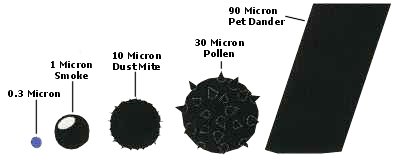Air Purifier Technology
Air Purifier Technology
Air purifiers or air cleaners are designed to make living spaces more comfortable. They reduce air pollutants that contribute to poor indoor air quality and many filter common allergens like dust and pollen - a great benefit for people suffering from asthma or allergies. If you're considering a room air purifier, keep these characteristics in mind:
They're portable. Many room air purifiers can go with you. If your den and your bedroom are similar sizes, you can move your air purifier to the room you're in.
They're efficient. Some room air purifiers provide more filtering power than whole home units.
They're versatile. Different air purifier manufacturers offer different features, styles, and filtering technologies to meet different consumer needs.
Air Purifier Filtering Technologies
HEPA FILTERS
HEPA stands for High Efficiency Particulate Air, and like the name says, these filters are designed to remove 99.97% of all airborne pollutants 0.3 microns or larger from the air that passes through the filter (these include tobacco smoke, household dust and pollen).
Here is an idea of the size of particles we are talking about:

ULPA FILTERS
These ultra-HEPA filters are designed to trap 99.999% of all airborne particles 0.3 microns or smaller from the air that passes through the filter (these include tobacco smoke, household dust and pollen).
CARBON FILTERS
Carbon filters are often used in combination with HEPA filters to reduce or eliminate odors, gases, VOCs in the air. Although more carbon can be helpful, it can reduce air flow.
PROBIOTICS like BETTERAIR
When the highest quality, FDA probiotics are released into the air it creates a better balance of negative bacteria to positive bacteria creating a healthier air environment. This has been proven as an extremely successful technology especially with dust mites, common allergens, odors, mold, viruses, bacteria and more. It is not recommended for smoke or heavy VOCs as those found in some foreign countries. In these cases, it is recommended to use the BetterAir systems in conjunction with a purifier that utilities a filter system such as Carbon and HEPA>
ELECTROSTATIC FILTERS
Electrostatic units filter the air using static electricity and have a static charge on the filter to allow airborne particles to "stick" to the filter, just like static-charged clothing sticks together.
ELECTROSTATIC PRECIPITATORS
These air purifiers create opposite charges on the metal plates or wires in a filter assembly. They attract the dust, pollen, smoke and other particles to the plate or grid wire that contains an opposite charge. The assembly can be washed of the particles and used again.
IONIZATION
Ionizers may be combined with other technologies, including different types of filters. Ionization units emit a small charge to the airstream which cause particles to adhere to the filter or other surfaces by a magnetic-like attraction.
Photo Catalytic Oxidation (PCO) LIKE FIELD CONTROLS
Field Controls patented PRO-Cell catalytic grid transforms odors and VOCs into fresh, breathable air. With 7 patents, the PRO-Cell ranks the TRIO Portable air purifier among the leading air purifiers on the market. Fresh air exits the TRIO Portable after it passes through the patented PRO-Cell. This 722 sq in of titanium infused photocatalytic grid, the PRO-Cell technology transforms odors, smoke, and VOCs info healthy air.
Ozone (we do not promote ozone generators)
Let me first tell you that our store's belief is that NO OZONE is the best ozone. Therefore, we do not sell ozone generators. Although these may be effective for smoke and other toxins, it is a chemical that can be harmful. As a chemical, it can mix with the air and travel by air currents into your breathable area. Once inhaled, it can combine with the moisture in your lungs and be harmful to your health.
Ultraviolet (aka UV)
UV is electromagnetic energy or rays. Unlike ozone which is a chemical. UV does not mix with the air bu travels by wave energy instead. Most common type is UVC. Used for germicidal effects to neutralize and reduce airborne odors, gases, VOCs, mold, viruses, and bacteria.
UVC (Ultraviolet Wavelength C)
UVC is shortwave UV which includes germicidal ultaviolet at 253.7 nm wavelength and is used for air, surface, and water disinfection. High intensity UVC germicidal lamp neutralizes and reduces airborne mold, bacteria, and viruses.
Courtesy of: The Association of Home Appliance Manufacturers (AHAM) - A Consumer Advocate Group, and Field Controls.